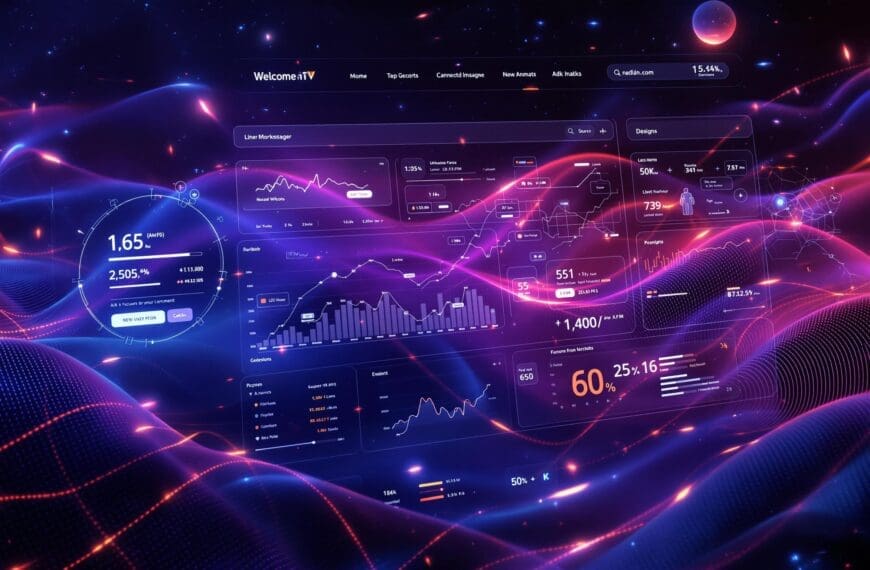Have you ever felt lost when faced with a complex web interface? This article takes an in-depth look at the web interface – that indispensable digital bridge between you and technical systems. Find out how to design an intuitive, high-performance user experience, taking advantage of the latest innovations and best design practices. Indeed, the aim is to make interaction as fluid and enjoyable as possible, taking into account users’ needs and expectations, while making the most of the capabilities offered by today’s technologies. The web interface: a digital bridge between users and systems The web interface is like the face of an application on the Internet. It’s made up of web pages and enables applications to be used directly via a browser. It serves as the link between us – the users – and the technical system. It makes interaction possible and easy to understand. To illustrate in concrete terms the essential components of a web interface, here are the key elements that contribute to a high-performance user experience: Zoning: Zoning is a bit like laying the foundations. It’s the first step in the design process, and involves positioning the various content blocks and organizing the site’s web pages as a whole. This lays the foundations for the main functionalities. This stage comes after the design of the site’s tree structure, but sometimes the two are built at the same time. Wireframe: The wireframe is the logical continuation of zoning. This stage consists of integrating real or fictitious content into the blocks defined above. The focus is on ergonomics, shapes, content and organization of elements, without worrying about looks. The interface design must meet the customer’s needs while respecting ergonomic standards. Mock-up: The mock-up transforms the wireframe into a dynamic, clickable HTML page. This allows links to be inserted and the interface to be made functional. The site’s title structure is also made visible, so that key HTML tags can be viewed for SEO purposes. A good mock-up allows the customer to project how the site will function. Prototype: The prototype is the final stage. It consists of making all the website’s interfaces interactive and functional, in order to test navigation and detect any errors directly from the CMS. In this way, we move from UI (User Interface) to UX (User Experience) by testing the overall user experience on the website. In particular, we check that the site is responsive, that the web design is adapted to the target audience, and that navigation is fluid and intuitive. In other words, we make sure that the site works well on all devices, that its appearance matches expectations and that visitors can navigate easily. User interface (UI) elements: UI elements are the components or building blocks used in software and web design. They are used to create the interface through which users interact with an application. They guide the way users use a product and clearly display information. Good organization of these elements makes for a smoother, more enjoyable user experience. In conclusion, these elements, combined with thoughtful design, guarantee effective man-machine communication and an optimal user experience. The evolution of web interfaces has been constant. They have evolved from the static pages of the 1990s to the mobile era of today. This transformation has led to improved user interaction; web interfaces have adapted to user needs and technical innovations. To find out more about the features of the web interface, see the official Nextcloud documentation. GitLab offers a Web Editor, a browser-based tool for editing GitLab repositories without local configuration. Architecture and design of a high-performance interface The foundations of UX/UI design The design of a high-performance web interface is based on a user-centered methodology. The “mobile-first” approach is also important. These principles guide the design of the interface to make it more intuitive for the user. Discover the key points to know about creating a website in 2025. Optimize your website with our complete guide to SEO. To find out more about website design, take a look at our dedicated article. Benchmarking web performance analysis tools Tool Main features Benefits Google PageSpeed Insights Tests speed and performance on mobile and PC. Provides a performance rating. Underlines areas for improvement according to Google’s criteria. GTmetrix Website performance monitoring. Provides comprehensive reporting, actionable recommendations and historical performance data, as well as comparisons with other sites. Pingdom Speed Test Tests site speed in real time. Provides real-time monitoring and detailed reports. Lighthouse Comprehensive analysis of performance, accessibility and best practices. Integrated with Google Chrome developer tools. Open source tool. WebPageTest Speed tests from multiple locations with different browsers. Provides in-depth technical details, multi-location testing and detailed recommendations. Legend: This table compares the most popular web performance analysis tools, highlighting their key features and benefits. Integration of WCAG accessibility standards and responsive design are important. They not only make a web interface accessible, but also guarantee multi-screen adaptability, ensuring an optimal user experience on all types of screen and for all users. Technical structure and key components The interaction between front-end and back-end is crucial in modern web applications. Data flows between the browser and the server, enabling information to be displayed and manipulated by the user via the web interface. Optimizing the performance of a web interface involves lazy loading and asset compression, two techniques that improve page loading times and reduce data consumption, thus offering a better user experience, particularly on mobile devices. Technological revolutions and new interactions Conversational AI and animated micro-interactions are changing the game for web interfaces. Indeed, machine learning is transforming these interfaces by enabling communication in natural language, while animations enhance the user experience. The growing adoption of Web Components and PWAs (Progressive Web Apps) is ushering in a new era. Progressive web applications offer numerous advantages, particularly in terms of performance and accessibility. Web Components modularize development, making code easier to maintain and extend; this is a significant advantage – as it enables developers to concentrate on creating innovative functionality rather than spending time on

















